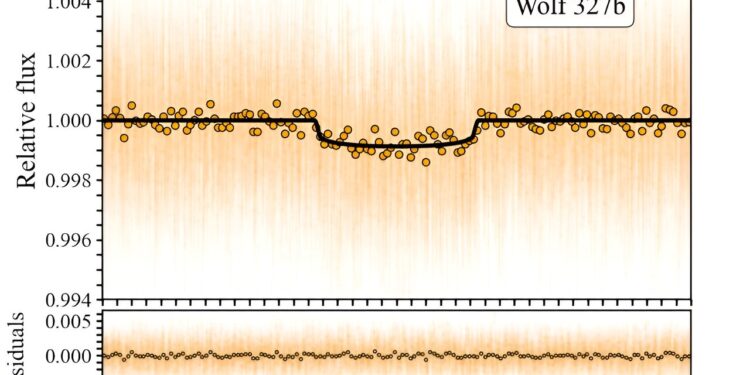TESS phase-folded light curve of Wolf 327 b after subtracting photometric variations from the time series (top panel). The best-fit transit model is shown in black, circles are TESS pooled observations. Bottom panel: residuals from the fit. Credit: Murgas et al., 2024.
Thanks to NASA’s Transiting Exoplanet Survey Satellite (TESS), an international team of astronomers has discovered a new very short-period exoplanet. The new alien world, designated Wolf 327 b, is slightly larger and about 2.5 times more massive than Earth. The discovery was reported in a paper published Jan. 22 on the preprint server. arXiv.
To date, TESS has identified more than 7,000 candidate exoplanets (TESS Objects of Interest, or TOI), of which 415 have been confirmed so far. Since its launch in April 2018, the spacecraft has studied about 200,000 of the brightest stars near the sun in an effort to search for transiting exoplanets, ranging from small rocky worlds to gas giants.
A group of astronomers led by Felipe Murgas of the University of La Laguna, Spain, now reports confirmation of another TOI monitored by TESS. According to the newly published study, a transit signal was identified in the light curve of Wolf 327, a nearby M dwarf star. The planetary nature of this signal was confirmed by tracking photometry, high-resolution imaging, and radial velocity (RV) measurements.
“Detection of transit events was conducted by NASA’s TESS mission, and ground-based observations confirmed that transit events are occurring on the star Wolf 327. RV tracking measurements taken with the CARMENES spectrograph told us made it possible to establish the mass of the candidate and confirm its planetary nature,” the researchers wrote.
Wolf 327 has a radius of 1.24 Earth radii and its mass has been measured at 2.53 Earth masses, giving an apparent density of 7.24 g/cm.3. The planet orbits its parent star every 13.7 hours at a distance of about 0.01 AU from it, and its equilibrium temperature is estimated to be almost 1,000 K. Therefore, Wolf 327 ba was classified by Murgas’ team as a super-Earth ultrashort-period (USP) star.
The results suggest that Wolf 327 b is a rocky planet with an internal composition similar to that of Mercury. Astronomers assume that this exoplanet has a large iron core surrounded by a small layer of mantle and has a negligible hydrogen and helium atmosphere.
As for Wolf 327, it is a 4.1 billion year old M dwarf, spectral type M2.5 V, located approximately 93 light years away. The star is only 40% the size and mass of the sun, has an effective temperature of 3,542 K, and an estimated metallicity of about -0.17 dex.
Summarizing the results, the paper’s authors say it is an interesting addition to the known sample of USP planets orbiting M dwarf stars, due to its interesting internal structure and measurements. favorable for secondary transit detection with the James Webb Space Telescope (JWST). ). According to the authors, there is also a high probability that other planets also orbit Wolf 327, given that USPs are usually found in multi-planet systems.
More information:
F. Murgas et al, Wolf 327b: A new member of the pack of ultra-short-period super-Earths around M dwarfs, arXiv (2024). DOI: 10.48550/arxiv.2401.12150
Journal information:
arXiv
© 2024 Science X Network
Quote: New wolf in the pack: astronomers discover an ultra-short period super-Earth (January 30, 2024) retrieved January 30, 2024 from
This document is subject to copyright. Except for fair use for private study or research purposes, no part may be reproduced without written permission. The content is provided for information only.



